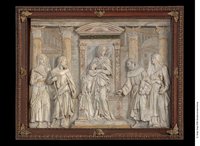Attributed to Giovanni da Pisa – after Donatello?
Giovanni di Francesco da Pisa, active in Padua in 1447-1448; died in Venice, shortly before 1460.
Virgin and Child
ca. 1450-55
Terracotta
75 x 54.5 cm
Berlin, Staatliche Museen, Skulpturensammlung, Inv. SKS 2949.
Bode-Museum, on view.
Provenance
Berlin, Adolph von Beckerath (until 1902); Berlin, Skulpturensammlung/Altes Museum (1902-1904); Berlin, Skulpturensammlung/Kaiser-Friedrich-Museum (1904-1939); Berlin, storage (1939-1945); Merkers, storage (1945); Wiesbaden, Central Collecting Point (1945-1956); West Berlin, Skulpturensammlung/Museum Dahlem (1956-1990); Berlin, Skulpturensammlung/Museum Dahlem (1990-1997); Berlin, storage (1997-2006); Berlin, Skulpturensammlung/Bode-Museum (since 2006).
Acquisition
Bought from Adolph von Beckerath in 1902 (acquisition file n°S479/02, untraced).
Curatorial Files in the Bode-Museum
Undated thermoluminescence, indicating the period 1450-78.
Other versions
• Vienna, Liechtenstein Museum, Inv. SK 133. Terracotta, 70 x 52 cm (without frame); 95 x 79.5 cm (with frame). Provenance: Stefano Bardini Florence (1900). No cushion on the edge. Modern frame.
• Detroit, Institute of Arts, Inv. 31.37. Terracotta, 76.8 x 54.3 cm. Acquired in 1937.
• Whereabouts unknown. Fragmentary, painted stucco. Negative 1538 BR of the Bardini archive in the Florence municipality (see Caglioti 2008, p. 90).
Comment
This relief in terracotta, especially refined, represents the Virgin and Child in an intimate embrace, the mother gently carrying her son while he holds her neck to kiss her cheek. The figures emerge from a sophisticated architectural setting, a niche seen in perspective decorated with two beautiful vases filled with ears of wheat, and two garlands attached at the top. On the buttresses flanking the niche stand pairs of musician putti.
Many aspects of the work have been connected with the art of Donatello: the tenderness between the Virgin and Child (even the reaching gesture of the latter), the dynamic draperies of the Virgin, the classic yet inventive architecture, and the use of putti (see for instance the Cavalcanti Annunciation in Santa Croce, Florence or the Brancaccio Tomb in Sant’Angelo a Nilo, Naples, but also, in the Berlin Sculpture Collection: Inv. SKS 3044; Inv. SKS M 7). However, the name of Donatello was never directly pronounced in conjunction with this composition, as the style seems somewhat gentler (and slightly weaker) than that of the master. Soon after its acquisition by the Berlin Museums, Bode 1902 drew attention to similarities with the High Altarpiece of the Ovetari chapel in the church of the Eremitani in Padua (destroyed during WWII), a work attributed since the 16th century by Marcantonio Michiel to a pupil of Donatello, Giovanni da Pisa. Such an attribution was endorsed by Schottmüller 1913 in her first edition of the catalogue of the Berlin Sculpture Collection; but the work disappeared from the second edition (Schottmüller 1933), most probably because the author suspected it to be a forgery (Middeldorf 1938 regretted this omission). The relief was little studied during the Cold War, as it stayed in East Berlin starting in 1958 (it was even declared lost by Sandner 1967; and in European Works of Art… 1990). Recently, Caglioti 2008 reaffirmed its authenticity, reassessing the attribution to Giovanni da Pisa, which he extended to a Virgin and Child bought as a work by Donatello by the Kimbell Museum of Art, Fort Worth in 2006 (see The Borromeo Madonna… 2006, which exaggerates the differences between the two reliefs).
The attribution to Giovanni da Pisa of the altarpiece of the Ovetari Chapel has been challenged in a 1994 Ph.D. thesis by Keith Vernon Shaw, who gave to the artist only the left half of the relief, ascribing the other half to the painter Nicolò Pizolo, who is indeed documented as working on the altarpiece. On the basis of this theory, Gentilini 1999 challenged
Entstehungsort stilistisch: Padua
de

